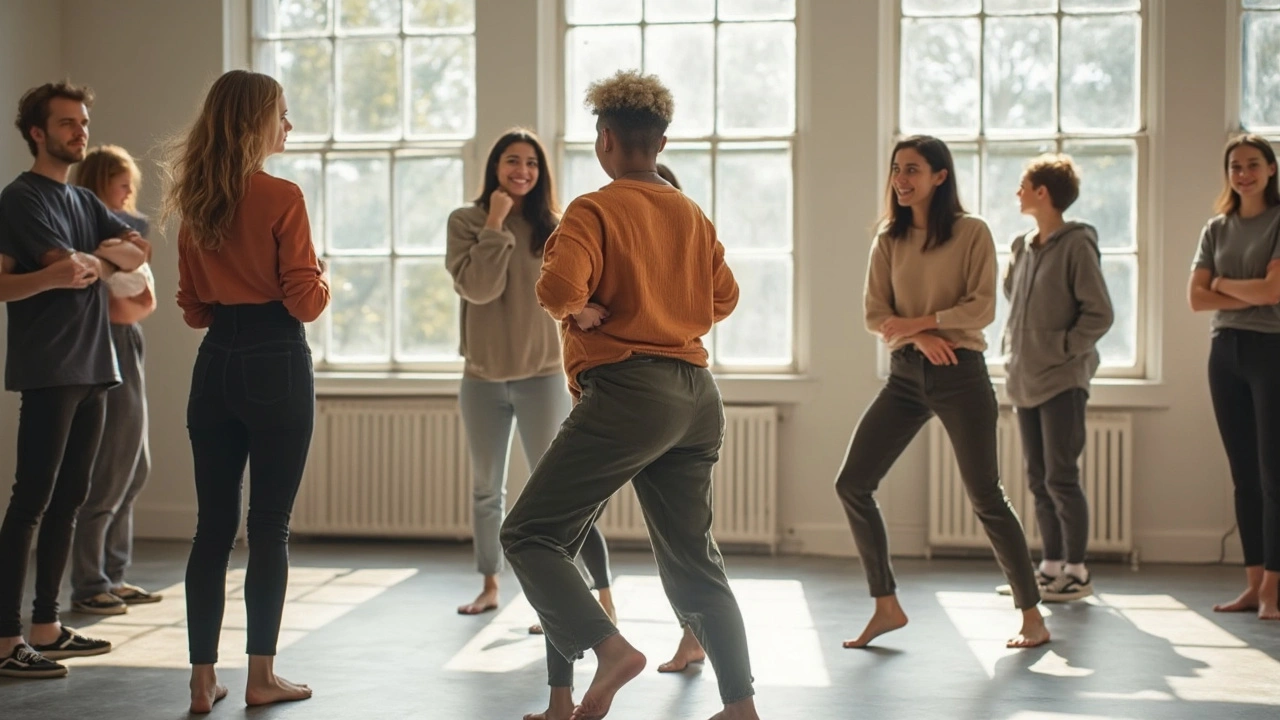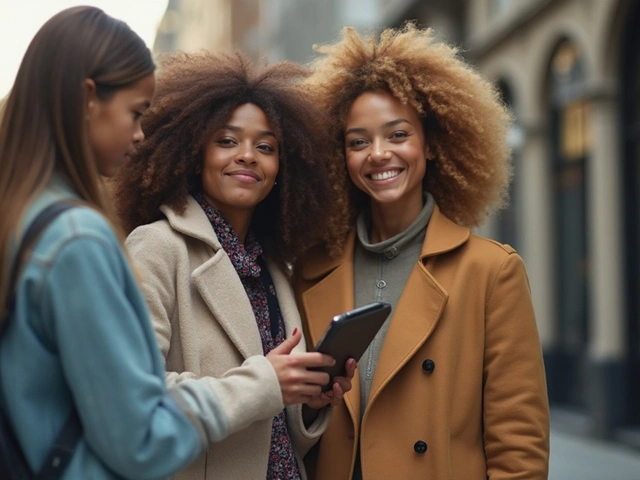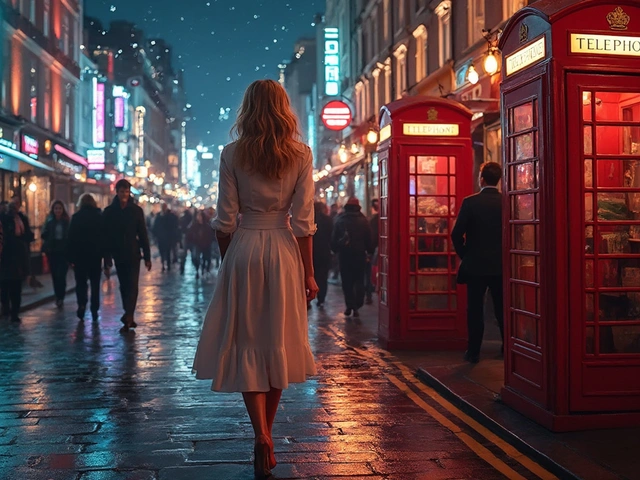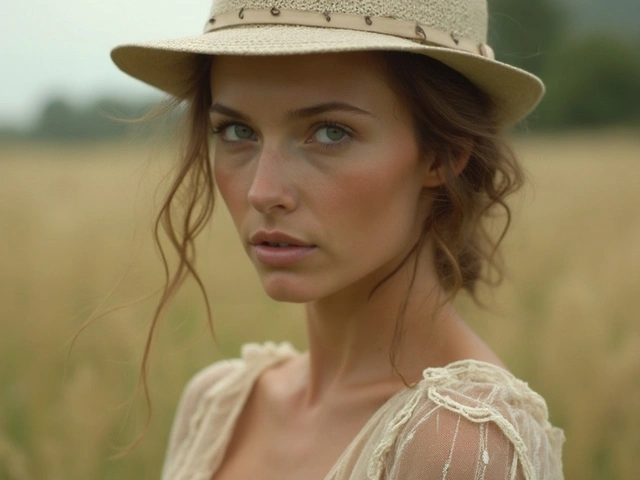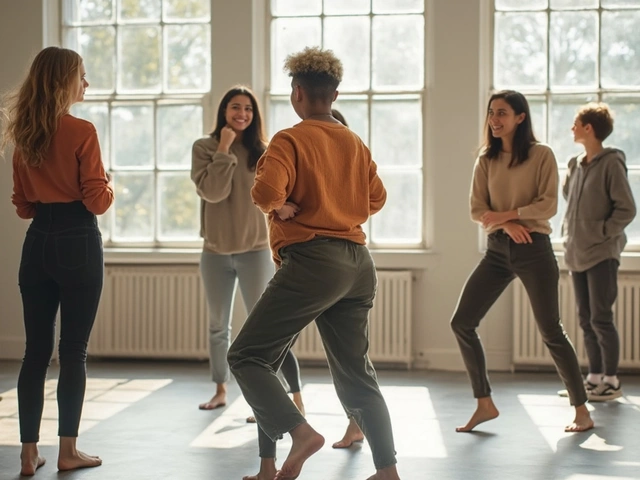So, you've got a camera pointed at you, and for a split second, you freeze. It happens to everyone in the beginning. The truth is, looking natural and effortless in front of the lens is a skill you can learn just like anything else—no natural 'posing gene' required.
The very first thing to get comfortable with: your body posture. No need to invent anything wild. Start by standing up straight, pulling your shoulders back a bit, but keep it loose—don't lock up like a robot. Most great photos begin with this simple trick. Your spine is like the anchor for every pose.
If you catch yourself feeling awkward, switch your weight from one foot to the other. This tiny move wakes up your whole look and makes you look more real, less like you're waiting for school pictures. Even when you practice in front of a mirror or your phone, these basics will set you up to nail those shots, instead of dreading them.
- What Makes a Great Model Pose?
- Posture: Your Secret Weapon
- Easy Arm and Hand Positions
- What to Do With Your Face
- Simple Poses to Practice
- Common Mistakes and How to Fix Them
What Makes a Great Model Pose?
The basics matter way more than you might think. A great model pose grabs your eye because it looks natural, even if it’s been practiced for hours. At its core, a winning pose brings out your personality, fits the mood of the shoot, and highlights your best features (while hiding stuff you don’t want in the spotlight).
If you’re just getting started, here’s the deal: it’s not about memorizing a million poses you saw on Instagram. Instead, get the fundamentals down. Think of it like sports—if your form is off, nothing else works.
- Model poses work best when they show a relaxed, confident vibe. Even if you’re nervous, try to act chill. Shoulders down, chin up a little, and avoid stiff lines.
- Angles are everything. Turning your body slightly from the camera (instead of facing it head-on) makes you look slimmer and adds depth to the picture.
- Your eyes and mouth can say a lot. A genuine smile or a focused gaze goes further than a fake “say cheese” grin.
- Hands are always tricky. If you don’t know what to do, keep them soft—gently touching your face, waist, or in your pockets works way better than letting them hang.
Here’s a real-world fact: Many pro photographers tell new models that 70% of a great shot comes down to strong posing and only 30% to fancy lighting or editing. When you hear about so-called “classic” poses, what that really means is they help you look taller, more confident, and relaxed.
| Element | Why It Matters |
|---|---|
| Posture | Shows confidence instantly |
| Angles | Adds shape, avoids flat photos |
| Facial Expression | Sells the mood |
| Hand Placement | Keeps your look natural |
When you try any pose, always check the little details: Are you tensing up your jaw? Did your hand slip into a weird claw shape? Catching these things early makes a world of difference in photos. Small adjustments can turn an okay pose into one you’d actually want to post.
Posture: Your Secret Weapon
Most beginners think model poses are all about doing something wild with your arms or legs, but the real magic often comes down to your posture. If your posture looks wonky, the photo will, too. This isn’t just about standing up straight—it's about small tweaks that make a big difference.
Let’s get real for a second: slouching can make you look unsure, tired, or even a bit invisible in images. And the photographer doesn’t want to spend hours editing out bad posture. Studies show that people who stand with good posture are seen as more confident and attractive, and that definitely shows up in photos. Even in fashion catalog shoots, pros return to posture basics every time because they work.
- Keep your feet about hip-width apart. This gives you a solid base.
- Roll your shoulders up, back, and then let them drop naturally. This keeps your upper body open.
- Imagine a string pulling the top of your head toward the ceiling. This helps your spine stay long (but don’t tense up).
- Bend one knee softly, even if you’re just standing still. It stops that stiff, statue vibe.
If you look at runway and print models, they use posture as a way to direct attention—so the clothes or product look their best. Even old-school supermodels like Naomi Campbell have talked about the "posture check" before stepping on set.
Sometimes, it’s worth practicing in front of a mirror or even recording yourself to spot posture mistakes you can’t feel. You want a straight back, relaxed shoulders, and chin parallel to the ground.
| Common Mistake | Easy Fix |
|---|---|
| Slouching shoulders | Roll shoulders up, then back, then drop |
| Locked knees | Bend one knee to loosen up your stance |
| Chin too high or low | Keep chin parallel to the floor |
If you're trying to improve your model poses, good posture sets you up for everything else. Get it right, and you look more polished even before you move a muscle!
Easy Arm and Hand Positions
Your arms and hands can make or break a photo, especially for beginners. Ever notice how awkward arms look when they hang flat by your sides? Pro photographers will tell you: putting a little space between your body and elbows instantly makes you look more relaxed. It’s a trick every new model should use.
Start simple. Bend one arm slightly at the elbow—think about holding a purse strap or lightly touching your hip. Not sure what to do with your hands? Give them a small job. Touch a pocket, hold a jacket edge, or gently brush hair aside. If it feels stiff, shake out your hands before a shot. This works wonders for tension, which is obvious in photos.
Here are a few go-to model poses for arms and hands that work for almost everyone:
- Hand in Pocket: Slide your thumb or whole hand in a pocket. Keep your arm relaxed—not ramrod straight.
- Hip Touch: Place your hand gently on your hip or just press your fingers to your waist. This creates shape and gives you a confident look.
- Hair Play: Lightly run fingers through your hair or tuck a strand behind your ear. It’s casual but adds energy to a shot.
- Crossed Arms: Works best if you keep it loose—imagine you’re just waiting for a friend, not shielding yourself.
Hand tension is sneaky. According to a poll from a 2023 modeling workshop, 64% of beginners say their hands are the hardest part to manage during a shoot. That’s because clenched fists or stiff fingers look unnatural. Instead, let your hands breathe—slightly curved fingers look more chill and less staged.
| Hand Mistake | Easy Fix |
|---|---|
| Flat palms facing camera | Angle hands or show the side—much more flattering |
| Clenched fists | Keep fingers soft and gently separated |
| Hidden hands | Let at least part of your hand show in the shot |
When I shoot practice photos of my kids—Hugo loves making ninja poses—these tweaks make a huge difference. The same tips work no matter your style or experience. Once you remember to give arms and hands a little job, those awkward photo moments start to disappear.
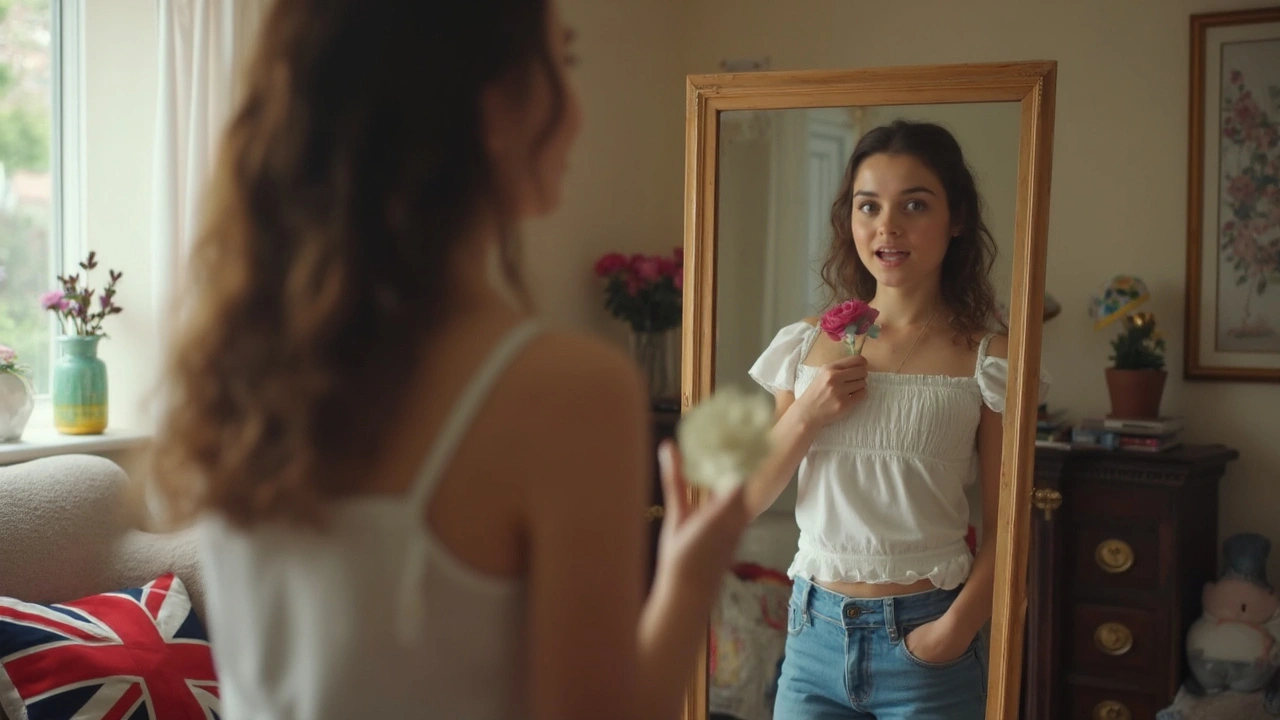
What to Do With Your Face
Your face might be the first thing people notice in a photo, and most beginners either overthink it or freeze up. The trick is remembering that even the best model poses rely on natural expressions, not forced smiles or blank stares.
One fact: research shows people connect more with photos when the expression is relaxed and matches the mood. The old advice 'smile naturally' still holds, but not every shot has to be a big grin. Sometimes, a soft smile or even a neutral, calm look works better.
Fashion photographer Lindsay Adler puts it perfectly:
"A good model doesn't just pose with their body, but tells a story with their eyes and mouth—even small changes matter."
This doesn’t mean you need to be dramatic. Here are specific things you can do so you don’t look stiff or awkward on camera:
- Relax your jaw. Don't clench. Try gently parting your lips for a more effortless vibe.
- Engage your eyes. Instead of just staring, pick a spot just above or next to the lens and imagine focusing on something or someone you like. This creates a more real, less 'deer-in-headlights' look.
- Play with angles. Lowering or turning your chin slightly can flatter your features way more than facing the camera head-on.
- Change up your expression. Try a little smirk, try a big smile, then do a soft, almost-serious glance. Don’t stick to one look for every shot.
- Avoid the "over-smile" that lifts your shoulders or creates too many wrinkles. A softer smile, or just a "smize" (smiling with your eyes), often flatters best.
If you feel awkward, practice in a mirror or snap a bunch of test selfies. Study the ones you like—maybe the best shot isn’t the one with your widest grin. As silly as it feels, this is what the pros do, too. Hugo and I sometimes have selfie contests at home (he usually wins, somehow).
Want some real-world numbers? Here’s what a study from Getty Images found in 2023 about top-performing fashion model photos online:
| Expression Type | % of Top-Performing Images |
|---|---|
| Relaxed Smile | 34% |
| Neutral/Calm | 47% |
| Big, Cheerful Smile | 11% |
| Serious/Focused | 8% |
The takeaway? Over-the-top grins aren’t needed. Most high-impact photos feature faces that look relaxed, calm, or softly smiling. So, next time you’re trying out model poses, remember: let your face do less—just let it feel real.
Simple Poses to Practice
You don't need to master high-fashion poses right away. Starting out, you just want to look relaxed and natural in your photos. Practice a few go-to model poses and you'll be ready for anything from phone pics to test shoots.
Here are beginner-friendly poses that really get results:
- The Classic "S" Curve: Stand straight, shift your weight to one hip, and pop the opposite knee out a bit. Let one arm fall naturally, and lightly rest the other hand on your waist. This pose creates a soft curve that flatters almost everyone.
- Hand in Pocket: Loosen up by slipping one or both hands into your pockets (or just hook your thumbs). It gives your arms something to do and instantly makes you look more comfortable.
- The Walk: Pretend you're caught mid-step. Take a couple of real steps toward the camera so your body isn't stiff. Sometimes the best shots happen just before or after you move.
- Sitting Pose: If there's a chair or bench, sit up straight with your ankles crossed and lean forward slightly. Rest your elbows on your knees—but don't hunch. This comes off as friendly and confident.
- Crossed Arms: Cross your arms loosely across your chest—not tight. It’s a classic that says, “I’ve got this,” and works for both men and women.
Want to see how often these easy moves show up? Check out this breakdown from a 2024 survey of new modeling portfolios:
| Pose Style | Appeared in New Portfolios (%) |
|---|---|
| S Curve | 78 |
| Hand in Pocket | 72 |
| Walking | 55 |
| Sitting Pose | 63 |
| Crossed Arms | 48 |
Don’t feel like you have to stick exactly to this list. Feel free to tweak these poses so they fit your own style and body. Practicing in front of a mirror or your phone camera is smart—what looks natural in your mind might feel goofy until you see what works for you.
One last tip: Relax your face! Even the best body pose looks awkward if your expression is stiff. Breathe, and experiment with small smiles or soft looks until you find what feels right.
Common Mistakes and How to Fix Them
Even the best beginners trip up on a few classic mistakes when it comes to model poses. Most of these are easy to spot once you know what to watch for. If you want your photos to stand out and not end up looking uncomfortable, you’ve got to avoid these slip-ups.
- Stiff posture. New models almost always tense up. You’re not a statue! Try shaking out your limbs or taking a deep breath between shots. A loose body always looks more natural in photos.
- “T-Rex” arms. If your elbows are glued to your body, you’ll look awkward. Give your arms some space—bend them a bit or rest a hand on your hip. Watch any fashion campaign, and you’ll rarely see arms pressed to the sides.
- Forcing facial expressions. Plastering on a big fake smile rarely works. Instead, think of a memory or something funny. The expression will show up in your eyes and make your entire look feel genuine.
- Ignoring your hands. Hands can ruin or save a shot. Flat palms or clenched fists look stiff. Let your fingers relax, or have them play with a prop (like a jacket collar or your hair).
- Unflattering angles. If you’re square to the camera, you might look boxy. Angle your body slightly—just a few degrees—to create shape.
Here’s a quick rundown of problems and what you can do instead:
| Mistake | How to Fix It |
|---|---|
| Staring down the lens with a blank face | Think of a story or idea to create emotion in your face |
| Legs locked and together | Shift your weight to one side or cross an ankle for instant shape |
| Chin tucked or flying high | Push your chin slightly forward and down—this defines the jaw |
| Hands just dangling | Lightly touch your face, pocket, or an object, letting fingers relax |
If there’s one thing pros talk about, it’s how paying attention to the basic model poses will do more for your photos than fancy gear or wild backdrops. If something feels weird when you pose, it probably looks weird too. Fixing these little habits is a shortcut to looking more confident and relaxed, even if you’ve only had a camera in your face once or twice.
